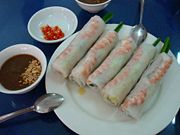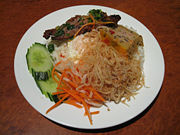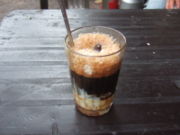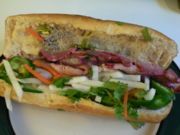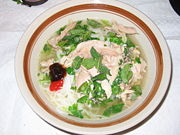Home > Vietnam > Vietnam Cuisine
CUISINE OF VIETNAM
Vietnamese cuisine is known for its common use of fish sauce, soy sauce, rice, fresh herbs, fruits and vegetables. Vietnamese recipes use many vegetables, herbs and spices, including lemon grass, lime, and kaffir lime leaves. Throughout all regions of Vietnam, the emphasis is always on serving fresh vegetables and/or fresh herbs as side dishes along with dipping sauce. The Vietnamese also have a number of Buddhist vegetarian dishes. The most common meats used in Vietnamese cuisine are pork, beef, chicken, shrimp, cockles and various kinds of seafood. Duck and goat are used less widely.
- The three regions
Vietnamese cuisine can be basically divided into three categories, each pertaining to a specific region. With North Vietnam being the cradle of Vietnamese civilization, many of Vietnam's most famous dishes (such as phở and bánh cuốn) have their birthplace in the North. The North's cuisine is more traditional and more strict in choosing spices and ingredients. The cuisine of South Vietnam has been influenced by the cuisines of southern Chinese immigrants, and thus Southerners prefer sweet flavors in many dishes. As a new land, the South's cuisine is more exotic and liberal, using many herbs. The cuisine of Central Vietnam is quite different from the cuisines of both the Northern and Southern regions in its use of many small side dishes, and also its distinct spiciness when compared to its counterparts
- Món nhậu (Food accompanying alcoholic beverages)
Exotic meats such as snake, soft-shell turtle, and goat are enjoyed almost exclusively while drinking alcoholic beverages, and are not considered typical everyday fare. However, dog meat consumption, while frowned in the South, especially in Saigon, is more widespread in the North, where it is considered a borderline mainstream meat, although not eaten nearly as often as pork or fish.[1] Dog meat can be difficult to find in larger cities, and tourists may not always see it. Hột vịt lộn is a fertilized duck egg with a nearly-developed embryo inside that is boiled and eaten in the shell. It's typically served with fresh herbs: (rau răm or Vietnamese coriander), salt, and pepper; lime juice is another popular additive, when available.
- The typical Vietnamese family meal
A typical meal for the average Vietnamese family would include: Individual bowls of rice A grilled, boiled,steamed, stir fried (with vegetable) or stewed, meat or fish or other seafood dish A stir-fried, raw or steamed vegetable dish canh (a clear broth with vegetables and often meat or seafood) or other Vietnamese-style soup Prepared fish sauce and/or soy sauce for dipping All dishes are communal and to be shared apart from the individual bowls of rice.
- Popularity of Vietnamese cuisine
Outside of its country of origin, Vietnamese cuisine is widely available in Australia, the United States, Canada, France, Japan, Czech Republic, Germany, Poland, and Russia, and is also popular in areas with dense Asian populations. In recent years it has become popular in other Asian countries such as South Korea, Laos and Thailand. Dishes that have become trademarks of Vietnamese cuisine include phở, bún, bánh mì (bread rolls), and gỏi cuốn (rice paper).
- Popular Vietnamese dishes include:
Noodle dishes Cao lầu Bún Bò Huế Chicken Pho Banh Hoi (Bánh hỏi): A special Vietnamese noodle that is extremely thin and woven into intricate bundles. Often topped with spring onion and a complementary meat dish, such as thịt heo quay, BBQ pork (often eaten at weddings). Bun thit nuong (Bún thịt nướng): thin rice vermicelli served cold with grilled marinated pork chops and nước chấm (fish sauce mixed with julienned daikon and carrot). A similar Northern version is bún chả with grill pork meatballs in placed of grilled pork chops. Bun cha (Bún chả): One of the more popular (and simple) Vietnamese dishes, basically a combination vermicelli plate, a kind of vermicelli counterpart to Cơm tấm. Grilled pork (often shredded) and vermicelli noodles over a bed of greens (salad and sliced cucumber), herbs and bean sprouts. Also often includes a few chopped up egg rolls, spring onions, and shrimp. Served with roasted peanuts on top and a small bowl of nước chấm. Bun Cha Gio (Bún chả giò): similar to bun thit nuong and bun cha, except the grilled meat is completely replaced by a couple of spring rolls served with chili fish sauce and greens. Cao lầu: A Hội An dish, made of specially burnt flavoured egg noodles topped with meats. Mì Quảng - a very popular yet extremely complicated noodle dish. Also originating from Quang Nam, Mi Quang varies in its preparation and features very sharply contrasting flavors and textures in (if prepared properly) a shallow filled bowl of broth, noodles, herbs, vegetables, and roasted rice chips (banh trang). Mi xao don (Mì xào dòn): Crispy deep-fried egg noodles, topped with a wide array of seafood, vegetables and shrimp in a gravy sauce.
- Noodle soups
Vietnamese cuisine boasts a huge variety of noodle soups, each with influences and origins from every corner of the country and each with a distinct and special taste. A common characteristic of many of these soups is a rich and very tasty broth. See also: noodle soup. Bún bò Huế – Spicy beef noodle soup originated from the royal city of Hue in Central Vietnam. Beef bones, fermented shrimp paste, lemongrass, and dried chilies give the broth its distinctive flavors. Often served with mint leaves, bean sprouts, lime wedges, shredded banana blossoms and shredded rau muống. Bun Mang Vit (Bún măng vịt): Bamboo shoots and duck noodle soup. Bun Oc (Bún Ốc): Vermicelli with snails (sea snails similar to the snails in French cuisine). Bánh canh, a thick udon-style rice noodle soup with a simple broth. Often includes pork, crab, chicken, shrimp, spring onions and freshly sautéed onions sprinkled on top. Bún riêu – noodle soup made of thin rice noodles and topped with crab and shrimp paste, served in a tomato-based broth and garnished with bean sprouts, prawn paste, herb leaves, water spinach, and chunks of tomato. Mi bo vien (Mì bò viên): Chinese influenced egg noodle soup with beef balls and shrimp, if served with won tons it is called wonton soup, or mì hoành thánh.
- Phở
beef noodle soup, It is a beef noodle soup with a rich, clear broth achieved from a long boiling meat and different herbs. There are many varieties of phở, with different selections of meats (most commonly beef and chicken) along with beef balls. Phở is typically served in bowls with spring onion, (in phở tai) slices of semi cooked beef (to be cooked by the boiling hot broth), and then of course the broth itself. The use of vegetables and various herbs is common in the southern region. Soups and porridges Canh chua, sour soupSup mang cua (Súp măng cua): A creamy bamboo-crab soup. Served typically as a first dish at banquets. Vietnamese hotpot: a spicy variation of the Vietnamese sour soup, with many vegetables, meats and seafood, as well as some spicy herbs. Also called lau (lẩu). Cháo gà: A chicken and rice porridge. Chao (Cháo): Rice congee. There are also a variety of different broths and meats used, including duck, chicken, offals, fish, etc. Canh chua: Vietnamese sour soup - typically include fish, pineapples, tomatoes, herbs, beansprouts, tamarind, and various kinds of vegetables, when made in style of a hotpot, it is called Lau Canh Chua.
- Rice dishes
Com chien Duong Chau : a Chinese fried rice dish, name after a region in China. It is a well-known dish in Vietnam. Com ga rau thom (Cơm gà rau thơm): Vietnamese mint chicken rice. Rice cooked in chicken stock and topped with chicken that has been fried then shredded, and flavoured with mint and other herbs. The rice has a unique texture and taste which the fried mint garnish enhances. Served with a special herb sauce on the side. Com hen (cơm hến): is a popular dish for the low-budget customers in the city of Hue and the vicinity. Cơm tấm – Generally, grilled pork (either ribs or shredded) plus a Vietnamese dish called bì (thinly shredded pork mixed with cooked and thinly shredded pork skin plus fried ground rice) over broken rice (what the words "com tam" actually mean in Vietnamese) and sweet and sour fish sauce. There are numerous types of meat prepared in various ways that are served with the broken rice. One can have barbecued beef, pork, or chicken served with the broken rice. The rice and meat are served with various greens and pickled vegetables, along with a prawn paste cake (chả tôm), trung hap (trứng hấp) and grilled prawns.
- Sticky rice dishes
Bánh chưng Bánh chưng : sticky rice wrapped in banana leaves and stuffed with mung bean paste, lean pork and black pepper, traditionally eaten during the Lunar New Year (Tet). Bánh chưng is popular in the North, while its cousin version bánh tét is more popular in the South. Bánh tét has the same content, except cylindrical in shape and the lean pork is substituted by fatty pork. Xôi: comes in a great varieties, but the general idea is sticky rice with coconut milk, cooked the same way as one cooks rice, or steamed for a firmer texture and more flavorful taste.
- Dumplings and pancakes
Banh bao (Bánh bao) Steamed bun dumpling that can be stuffed with onion, mushrooms, or vegetables. Bánh bao is an adaptation from the Chinese baozi to fit Vietnamese taste. Vegetarian banh bao are also available. Vegetarian bánh bao are popular food in Buddhist temples. Typical stuffings for bánh bao include slices of marinated xá xíu (BBQ pork from Chinese cooking) meat, tiny boiled quail eggs, and pork. Bánh bèo: a central Vietnamese dish consisting of tiny round rice flour pancakes, each served in a similarly shaped dish. They are topped with minced shrimp and other ingredients such as chives, fried shallots and pork rinds. Eaten with Nước chấm. Banh Bot Chien (Bánh Bột Chiên, fried rice flour cake): A Chinese influenced pastry that exists in many versions all over Asia; the Vietnamese version features a special tangy soy sauce on the side, rice flour cubes with fried eggs and some vegetables. This is a popular after-school snack for young students. Banh bot loc (Bánh bột lọc): A Hue food, consisting of tiny rice dumplings made in a clear rice flour batter, often in a small flattish tube shape. Stuffed with shrimp and ground pork. It is wrapped and cooked inside a banana leaf, served often as Vietnamese hors d'oeuvres at more casual buffet-type parties. Banh xeo (Bánh xèo) Vietnamese Crepe made out of rice flour with tumeric, shrimps with shells on, slivers of fatty pork, sliced onions, and sometimes button mushrooms, fried in one or two teaspoons of oil, usually coconut oil, which is the most popular oil used in Vietnam. It is eaten with lettuce and various local herbs and dipped in Nước chấm or sweet fermented peanut butter sauce. Rice papers are sometimes used as wrappers to contain banh xeo and the accompanying vegetables.
- Wraps and rolls
Bánh cuốn Thanh Tri Summer rolls with accompanimentsBánh cuốn: Rice flour rolls stuffed with ground pork, prawns and wood ear mushroom. They are eaten in a variety of ways with many side dishes, including one out of many kinds of chả (sausage). Bánh tráng: can be understood as either of the followings: Bánh tráng cuốn: thin rice flour sheet dried into what is commonly called "rice paper", used in making spring roll (aka chả giò), and summer rolls (aka gỏi cuốn) by applying some water to soften the texture. Bánh tráng nướng (in the South), or bánh đa in the North: These are large round flat rice crackers, which, when heated, enlarge into round, easily shattered pieces. They can be eaten separately, although they are most commonly added into the vermicelli noodle dishes like cao lầu and mì quảng. Many types of 'banh trang' exist, including the clear sesame seed ones, prawn-like cracker with dried spring onions, sweet milk, and so on. Bi cuon (bì cuốn): (Rice paper rolls with the bi (bì) mixture of thinly shredded pork and thinly shredded pork skin tossed with powdered toasted rice, among other ingredients, along with salad). Similar to summer rolls. Bo bia (Bò bía): Stir fried jicama and carrots, Chinese sausage, shredded scrambled eggs, all wrapped with vermicelli noodle in a rice paper roll. Dipped into a spicy peanut sauce (with freshly roasted and ground peanuts). It is of Chinese (Hokkien/Chaozhou) origin, having been brought over by the immigrants. It is common sight to see an old Teochew man or woman selling bò bía at their roadside stand. The name bò bía phonetically resembles its original name popiah in the Teochew language. Chả giò: a kind of spring roll (sometimes referred to as egg roll) – deep fried flour rolls filled with pork meat, yam, crab, shrimp, rice vermicelli, mushrooms ("wood ear" variety) and other ingredients. The spring roll goes by many names - as many people actually use (falsely) the word "spring roll" while referring to the fresh transparent rice paper rolls (discussed below as "Summer Rolls"), where the rice paper is dipped into water to soften and then rolled up with various ingredients. Traditionally these rolls are made with a rice paper wrapper but in recent years Vietnamese chefs outside of Vietnam have changed the recipe to use a wheat-flour-based wrapper. Salad rolls (Gỏi cuốn) also known as Vietnamese fresh rolls, or summer rolls. They are rice paper rolls that often include shrimp, herbs, pork, rice vermicelli and other ingredients wrapped up and dipped in nước chấm or peanut sauce. Spring rolls almost constitute an entire category of Vietnamese foods, as there are numerous different kinds of spring rolls with different ingredients in them.
- Vietnamese sandwiches and pastries
Banh Mi Thit (Bánh mì kẹp thịt) Vietnamese baguette, French bread containing paté, Vietnamese mayonnaise, different selections of Vietnamese cold cuts (of which there is a large variety, most commonly ham, head cheese, and a Vietnamese bologna), pickled daikon, pickled carrot, and cucumber slices. The sandwich is often garnished with coriander and black pepper. This food is common everywhere in Vietnam as a favorite of factory workers and students, and eaten for any meal of the day, commonly breakfast and lunch. There are a wide variety of banh mi (with different meats) and many shops have popped up across North America serving primarily Banh mi. Breakfast Banh mi: stuffed with scrambled eggs and canned sardines, or the more popular version: eggs fried sunny-side-up with onions, sprinkled with soy sauce and eaten with a fresh (and sometimes buttered) baguette. Paté Chaud: A French inspired meat-filled pastry. Characterized by flaky crust and either pork or chicken as the filling.
- Meat dishes
Sliced chả lụa served over bánh cuốn, and garnished with fried shallotsBo kho (Bò kho): Vietnamese beef and vegetable stew, often cooked with warm, spicy herbs and served very hot with French baguettes for dipping. Bo la lot (Bò lá lốt): spiced beef rolled in a pepper leaf (la lot)and grilled. Bo luc lac (Bò lúc lắc): Beef cut into cubes and marinated, served over greens (usually watercress), and sautéed onions and tomatoes. Eaten with rice. Bò 7 Món: Vietnamese seven courses of Beef. A less popular version is the Ca 7 Mon (Cá 7 Món) - or, seven courses of fish. Cha lua (Chả lụa): sausage made with ground lean pork and potato starch. Also available fried; known as chả chiên. There are various kinds of chả (sausage), made of ground chicken (chả gà), ground beef (chả bò), fish (chả cá), or tofu (chả chay, or vegetarian sausage). Ga nuong sa (Gà nướng sả): grilled chicken with lemon grass. Lemon grass grilled beef and other meats are also popular variations. Nem Nuong (Nem nướng): grilled meatballs, usually made of seasoned pork. Often colored reddish with food coloring and with a distinct taste, grilled on skewers like kebabs. Ingredients in the marinade include fish sauce. Nem Nguoi (Nem Nguội): A Hue dish and a variation of the Nem nuong meatballs, these also come from Central Vietnam. They are chilled, small and rectangular in shape, and stuffed with vermicelli. The reddish meat is covered with peppers and typically a chili. Very spicy, eaten almost exclusively as a cocktail snack.
- Seafood dishes
Ca cuon (Cá cuốn): A roll with fish and spring onions. Chao tom (chạo tôm): Prawn paste/cake on sugarcane. Mam (mắm): salted fish in various styles. The types of fish most commonly used to make mắm are catfish,snakeheads, and mackerels. The fish flesh remains in tact (this is how it is different from nước mắm), and can be eaten cooked or uncooked, with or without vegetables and condiments.
- Salads
Goi (Gỏi): salad. Many varieties with the most popular including: Gỏi đu đủ: Vietnamese papaya salad typically with shredded papaya, herbs, various meats such as shrimp, slices of pork, liver, or meat jerky, herbs, and with a more vinegar-based rendition of nước chấm. Gỏi Huế rau muống: a salad dish originating from Hue (Central Vietnam), including water spinach (Rau Muong). Gỏi ngó sen: lotus stem salad, with shrimp and pork or chicken.
- Vietnamese curry
Vietnamese curry is also popular, especially in the south. Curry chicken can be either similar to the Thai curries (w/coconut milk) or taste kind of like Caribbean curries (no coconut milk, and more stir fried instead of steamed like a soup), and is usually served with rice. Another type of well known Vietnamese curry is beef brisket curry or beef tail curry. The beef curries are often eaten with French bread for dipping, or eaten with rice.
- Condiments and sauces
Mắm tôm (shrimp paste) Nước mắm (fish extract)
- Desserts and Beverages
Chè is a sweet dessert or pudding usually made from beans and sticky rice. Many varieties of chè are available, each with different fruits, beans (for example, mung beans or kidney beans), and other ingredients. Chè can be served cold, cool or hot. Fruit smoothies (sinh tố) are also popular. They are simple to make and require just a few teaspoons of sugar, crushed ice and fresh locally available fruits. The smoothies come in many varieties, including custard apple, sugar apple, avocado, jackfruit, durian, strawberry, passionfruit, dragonfruit, lychee, mango, and banana. Another dessert is Vietnamese yogurt made with condensed milk. Due to French colonial rule, flan has become a popular Vietnamese dessert. Deep-fried banana with ice cream, usually vanilla or coconut, is popular in restaurants. Nước mía: fresh sugar cane juice, served with ice. Cafe sua da (Cà phê sữa) – strong iced coffee, most often served with sweetened condensed milk at the bottom of the cup to be stirred in. A Vietnamese favorite. Also a popular beverage is bubble tea.
- Vegetables
- Bitter melon (khổ qua)
- Bok choy (cải bó xôi)
- Cabbage (cải bắp)
- Carrot (cà rốt)
- Cauliflower (súp lơ or bông cải)
- Chayote (su su)
- Chili pepper (ớt)
- Cucumber (dưa leo)
- Daikon (củ cải trắng)
- Eggplant (cà tím)
- Water spinach (rau muống)
- Fruits
- Durian (sầu riêng)
- Jackfruit (mít)
- Pitaya - dragon fruit (thanh long)
- Lychee (vải)
- Longan (nhãn)
- Tomato (cà chua)
- Rambutan (chôm chôm)
- Mango (xoài)
- Mangosteen (măng cụt)
- Guava (ổi)
- Cherimoya (mãng cầu tây)
- Sweetsop (na or mãng cầu ta)
- Soursop (mãng cầu Xiêm)
- Custard apple (bình bát)
- Water apple (roi in the north, mận in the south)
- Plum (mận)
- Star fruit (khế)
- Watermelon (dưa hấu)
- Langsat (bòn bon)
- Acerola (xê-ri)
- Sapodilla (hồng xiêm or xa-pô-chê)
- Pomelo (bưởi)
- Spondias cytherea; see Spondias genus (cóc)
- Green star apple (vú sữa)
- Persimmon (hồng)
- Papaya (đu đủ)
- Buddha's hand (phật thủ)
- Rose apple (roi in the North, mận Đà Lạt in the South)
- Canistel (trái trứng gà)
- Otaheite gooseberry (chùm ruột)
- Herbs (rau thơm)
- Thai basil (rau quế, húng quế, or rau húng quế, ; sometimes substituted with sweet basil in the United States
- Lemon grass (cây xả)
- Ngò gai (long coriander/culantro)
- Ngò ôm (rice paddy herb)
- Rau răm (Vietnamese mint)
- Coriander (rau ngò or ngò rí)
- Peppermint (húng cây or rau bạc hà)
- Spearmint (húng lủi)
- Houttuynia cordata (giấp cá or diếp cá)
- Perilla (tía tô)
- Dill (thì là)
- Elsholtzia ciliata (rau kinh giới)
- Bacopa monnieri (rau đắng)

